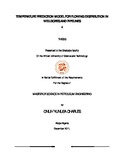| dc.description.abstract | Down-hole temperature and pressure data are important information needed to understand flowing conditions and production optimization. For example, knowing the wellbore temperature profile is useful in predicting the wax formation in the tubing, which is important in flow assurance.
While gas production usually causes a temperature decrease due to Joule Thomson effect, water entry results in warming of the wellbore. Warmer water entry is as a result of inflow from a warmer aquifer zone due to water coning. Water entry by water coning can therefore easily be detected from temperature profile since it increases the wellbore temperature.
In this study, we successfully developed a temperature prediction model which calculates temperature profiles for flowing temperature in the wellbore and considers Joule Thomson coefficient as a function of mass flow rate of the fluid phases (oil, water, and gas). We modified Alves et al temperature equation and the modified temperature equation was used to produce the work done by Alves et al which produces close result.
The model was used to investigate the effect of gas and water entry that created change in temperature profile along the wellbore. The temperature equation can be applied to pipelines or production and injection wells under single phase, two phase, and three phase flow, for horizontal, vertical, and inclined wells. Cases were considered to verify the effect of water and gas entry into the wellbore.
The result shows that water entry increases wellbore temperature and gas entry decreases wellbore temperature and also temperature profile is a function of the flow rate of the fluid. Since the prediction requires the fluid composition in the wellbore, accurate prediction of the temperature profile can give an idea of how much component of each fluid is present in the wellbore. | en_US |

